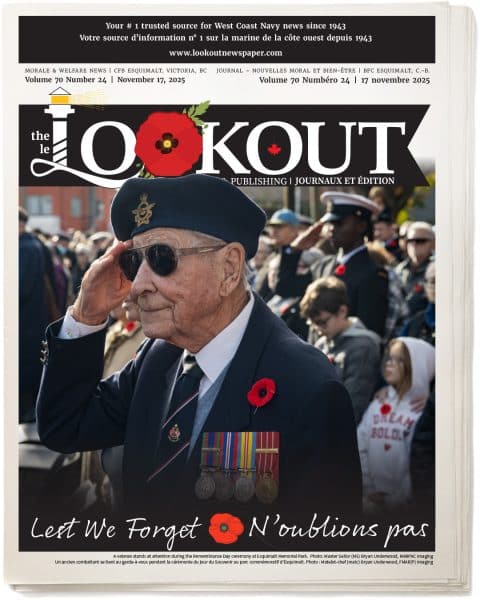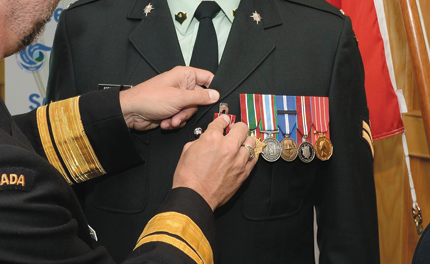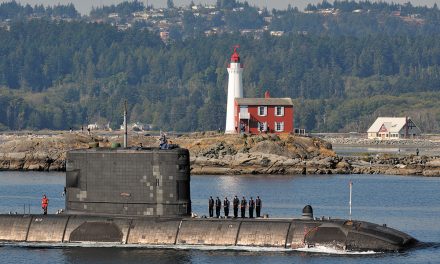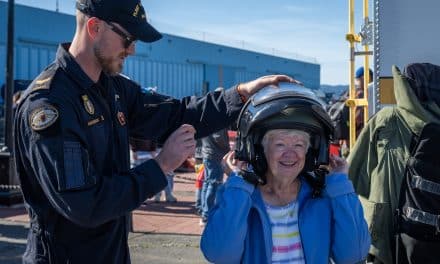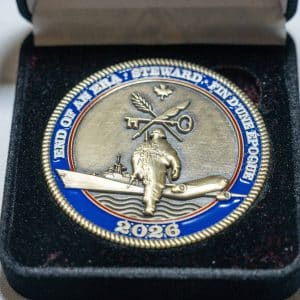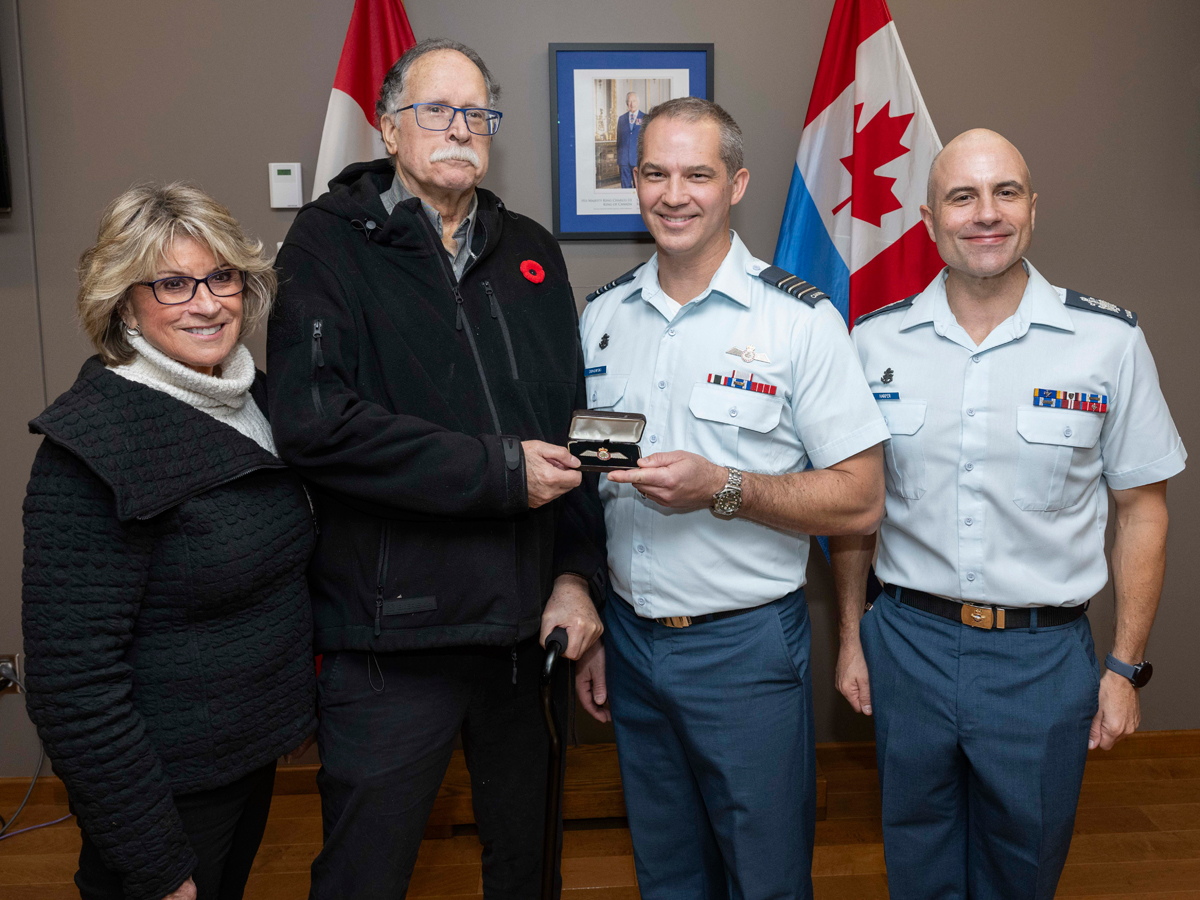
Mr. Jay Hammond receives a set of wings created using the aluminum of his uncle’s recovered Halifax bomber during a Commendation Presentation at 443 Maritime Helicopter Squadron on Oct. 18. Photo: Sailor 3rd Class Jordan Schilstra, MARPAC Imaging Services
Paul Dagonese,
Lookout Writer
—
As the Royal Canadian Air Force (RCAF) marks its Centennial year, two exceptional Canadians were celebrated for their significant contributions to Canada’s military history. In a ceremony on Oct. 18 at 443 Maritime Helicopter Squadron in North Saanich, Jay Hammond and Maureen Thom were recognized for their dedication over the past 13 years to find the site where their uncle’s plane went down in the Second World War and exhume the wreckage from seven metres below ground.
On May 12, 1944, Halifax Bomber LW682 carrying seven RCAF and one Royal Navy crew members was shot down by a Luftwaffe Messerschmitt Bf 110. The aircraft and its crew perished in the crash. Their remains were submerged in a Belgian marsh for decades. Fifty-three years later, the remains of Hammond’s uncle, Pilot Officer (P/O) Wilbur Boyd “Wib” Bentz, a Canadian bomber pilot, along with two of its crewmembers, Sergeant (Sgt.) J.W. Summerhayes and Sgt. F. Roach, were discovered at their Halifax Bomber’s crash site near Geraardsbergen, Belgium.
Lieutenant-Colonel Matt Dukowski, Commanding Officer of 443 Squadron, opened the ceremony by presenting Hammond with a unique tribute from the RCAF, a set of wings (rare for a civilian to receive) crafted from the aluminum of his uncle’s Halifax Bomber. In 2021, the RCAF began using material from the recovered bomber in the wings awarded to all active flight-qualified members. The metal serves as a link between today’s RCAF and the fallen aviators who laid its foundation. Since then, every wing bears the bomber’s tail number inscribed on the back.
LCol Dukowski called this a “very personal connection” for each recipient, as it represents a direct piece of RCAF history. “Hammond’s efforts created an enduring legacy that honours both his family and the entire RCAF community,” he said.
In a letter by Lieutenant-General Eric Kenny, Commander of the RCAF, read aloud at the ceremony, LGen Kenny commended Hammond’s 13 years of dedication to recovering the bomber and its crewmembers. “His dedication not only brought closure to his family but preserved a vital piece of Canada’s military heritage,” he wrote. “Jay is someone who has preserved his uncle’s memory in an incredibly special way.”
Hammond and Thom, who followed in her uncle’s footsteps to become a pilot, were also presented with the Commander’s Coin and the 443 Squadron Coin, limited to only 100 being presented in the RCAF’s Centennial year.
Moved by letters from his uncle, Hammond embarked on a journey to uncover his family’s wartime past. Determined to locate the crash site, Hammond worked closely with the Belgian Aviation History Association (BAHA), an organization committed to preserving aviation history.
In September 1997, Hammond joined by Thom, arrived at the Belgian marshlands to witness the initial dig. Volunteers gathered to assist, and soon, the aluminum fragments with the Halifax LW682 emerged from the soil, confirming they had found the right location. The dig was extensive, reaching nine meters below the surface and taking three full days to complete.
Hammond recalled the excitement when the first recognizable artifact surfaced.
“You could hear the squeal of the bucket of the excavator crushing aluminum,” he recounted. “And when we found the tail number, LW682, there was no doubt we had the right site.”
The excavation yielded poignant artifacts: a watch stopped at the moment of impact, a signet ring belonging to crew member Jack Edwin McIntyre, and parachutes.
Hammond’s journey took a surprising turn when he reached out to the Luftwaffe pilot who was known to have shot down the Halifax, Martin Drewes. Remarkably, Drewes accepted Hammond’s invitation to attend the funeral for the recovered crew in Belgium. On Nov. 10, 1997, eight headstones were placed for each fallen crew member at the site. At the back of the ceremony, Hammond recognized Drewes, who had quietly traveled from Brazil to pay his respects.
As Hammond reflected, he saw his connection to his uncle expand into a profound bond with the RCAF and its history while he admitted to looking at it through a lens of war. It could have been his uncle who shot down Drewes’ plane. The two men maintained a connection until Drewes’ passing in 2013.
The recovered bomber has contributed to projects commemorating the sacrifice of Canadian aircrews. Parts of the aircraft were incorporated into the restored Halifax NA337, now on display in Trenton and aluminum from the wreckage has been melted into ingots, some of which formed the roof of the Bomber Command Memorial in London, England, including the ceiling of the Hyde Park memorial where Queen Elizabeth dedicated the monument in 2012.
“Standing there, knowing a piece of our history was now a part of something so grand was indescribable,” Hammond said of attending the ceremony. “It was quite an honour to see that aluminum used in such a prestigious place.”
Today, artifacts from the crash Hammond has collected—a photograph of Bentz, his leather flying gloves, pieces of the Halifax aluminum, and defused incendiary shells, serve as lasting reminders of courage. Through Hammond’s devotion, these symbols continue to honour the legacy of a nephew’s mission to ensure his uncle’s memory endures in the RCAF’s proud heritage.
As the RCAF celebrates its 100th anniversary, this tribute to Jay Hammond and Maureen Thom underscores the Air Force’s commitment to honouring its legacy and those who shaped it. By recognizing their dedication, the RCAF ensures the memory of Canada’s fallen airmen continues to inspire future generations.
